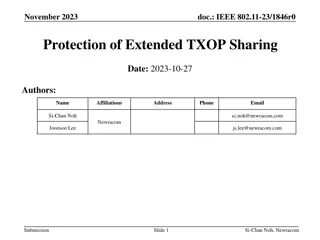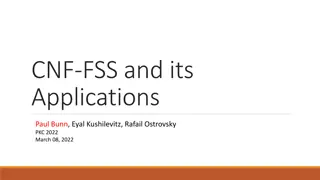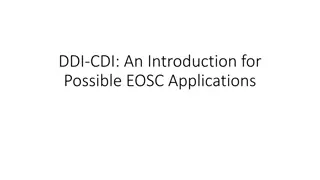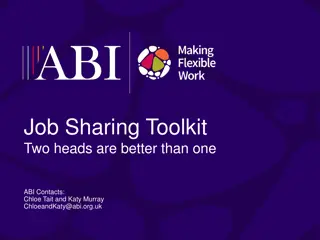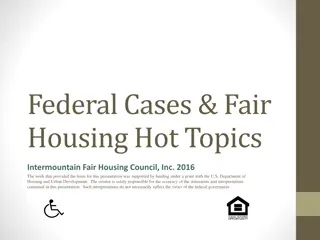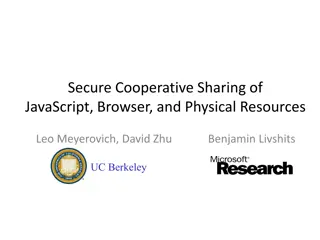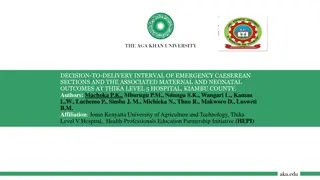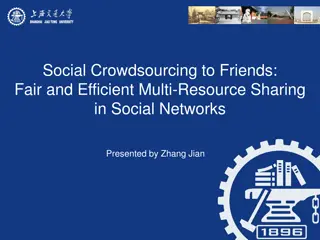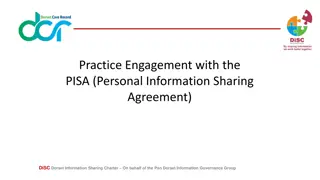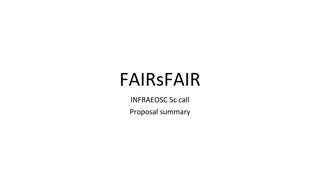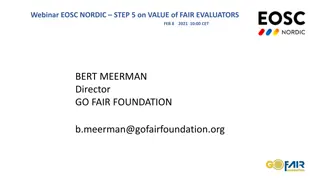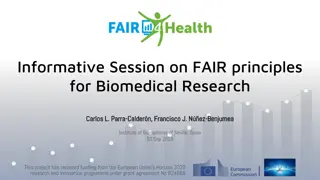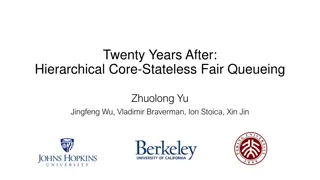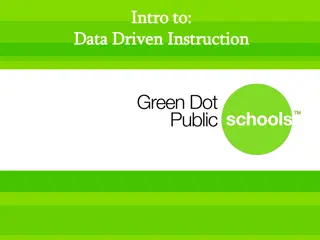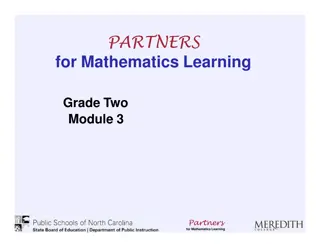Understanding FAIR Data and DDI - Implementing Data Sharing Best Practices
Explore the concepts of FAIR data and DDI, essential for sharing research data effectively. Learn how the Data Documentation Initiative (DDI) supports FAIR principles and enhances data quality. Engage in interactive quizzes to test your knowledge on FAIR practices.
Download Presentation

Please find below an Image/Link to download the presentation.
The content on the website is provided AS IS for your information and personal use only. It may not be sold, licensed, or shared on other websites without obtaining consent from the author. Download presentation by click this link. If you encounter any issues during the download, it is possible that the publisher has removed the file from their server.
E N D
Presentation Transcript
FAIR Data Sharing and DDI DDI Training Library Version 1.0 DDI Alliance, DDI Train the Trainers Workshop, DDI Training Working Group This work is licensed under Creative Commons Attribution 4.0 International License.
Overview What is FAIR? Where is the Metadata? The FAIR Ecosystem How DDI Supports FAIR
What is DDI? The Data Documentation Initiative (DDI) is a suite of metadata specifications for the Social Behavioral and Economic (SBE) sciences It is granular, machine-actionable (XML), and platform- independent Used by many data archives and producers throughout the globe
QUIZ: What is FAIR? An elaborate contemporary folk dance involving the energetic flapping of the jaws and waving of hands, followed by a prolonged period of inactivity A specific set of universally agreed practices for sharing research data, implemented by adhering to well-defined specifications applying equally across all domains A compelling article published in Nature in 2016, describing the basic principles which should be followed for sharing research data in sciences of all kinds
QUIZ: What is FAIR? An elaborate contemporary folk dance involving the energetic flapping of the jaws and waving of hands, followed by a prolonged period of inactivity A specific set of universally agreed practices for sharing research data, implemented by adhering to well-defined specifications applying equally across all domains A compelling article published in Nature in 2016, describing the basic principles which should be followed for sharing research data in sciences of all kinds
QUIZ: What is FAIR? An elaborate contemporary folk dance involving the energetic flapping of the jaws and waving of hands, followed by a prolonged period of inactivity A specific set of universally agreed practices for sharing research data, implemented by adhering to well-defined specifications applying equally across all domains A compelling article published in Nature in 2016, describing the basic principles which should be followed for sharing research data in sciences of all kinds
QUIZ: What is FAIR? An elaborate contemporary folk dance involving the energetic flapping of the jaws and waving of hands, followed by a prolonged period of inactivity A specific set of universally agreed practices for sharing research data, implemented by adhering to well-defined specifications applying equally across all domains A compelling article published in Nature in 2016, describing the basic principles which should be followed for sharing research data in sciences of all kinds
FAIR Is a (Simple) Idea Findable, Accessible, Interoperable, Re-usable Embodied in a set of principles ( The FAIR Guiding Principles )* Promote data-sharing and reuse Within and between domains Not a new idea! DDI has been focused on data sharing and reuse for decades The archival community is in the business of data-sharing and reuse Complex topic, not always clearly articulated Important ideas whose time has come Demand for more data (large projects, new technologies) More cross-cutting, multi-domain research (i.e., UN Sustainable Development Goals) Demand for data coming from more different sources Broader acceptance of data-sharing as important The key to FAIR data is metadata * Wilkinson MD, Dumontier M, Aalbersberg IJJ, Appleton G, Axton M, Baak A et al. The FAIR Guiding Principles for scientific data management and stewardship. Scientific Data. 2016;3. 160018. https://doi.org/10.1038/sdata.2016.18
FINDABLE F1 (Meta)data are assigned a globally unique and eternally persistent identifier F2 Data are described with rich metadata F3 (Meta)data are registered or indexed in a searchable resource F4 Metadata specify the data identifier
ACCESSIBLE A1 (Meta)data are retrievable by their identifier using a standardized communications protocol A1.1 The protocol is open, free, and universally implementable A1.2 The protocol allows for an authentication and authorization procedure, where necessary A2 Metadata are accessible, even when the data are no longer available
INTEROPERABLE I1 (Meta)data use a formal, accessible, shared, and broadly applicable language for knowledge representation I2 (Meta)data use vocabularies that follow FAIR principles I3 (Meta)data include qualified references to other (meta)data
RE-USABLE R1 (Meta)data have a plurality of accurate and relevant attributes R1.1 (Meta)data are released with a clear and accessible data usage license R1.2 (Meta)data are associated with their provenance R1.3 (Meta)data meet domain-relevant community standards
Some Things to Note All of the top-level principles mention metadata (at least once) Many things described are, in fact, metadata Identifiers (F1) Licensing (R1.1) Provenance (R1.2) Vocabularies (I2) Standards are important Persistent identification schemes require standards (F1) Protocols are a (technical) type of standard (A1) Knowledge representation hints at many popular standards (I1) Community standards are directly mentioned (R1.3) Qualified references implicitly require standards (I3)
The FAIR Ecosystem There is no single set of specifications for implementing FAIR data sharing There are organizations (and collaborative projects) which proactively support FAIR: GO FAIR Research Data Alliance (RDA) CODATA FAIRsFAIR Project European Open Science Cloud (EOSC) Including SSHOC/CESSDA Many, many others There is an emerging set of standards, protocols and approaches around FAIR FAIR Implementation Profiles (FIPs) FAIR Digital Objects (FDOs) FAIR Data Points (FDPs)
FAIR Implementation Profiles (FIPS) Description of what is being used by which FAIR communities Community-driven description of how FAIR is implemented Useful as an indication of what standards and vocabularies are likely to be found Helpful in locating significant repositories of data and metadata Meant to be machine-readable, may be machine-actionable Still under discussion Uses a standardized form to collect information from projects/communities Notionally, FIPS are the contents of a catalogue of catalogues highlighting relevant resources https://www.go-fair.org/how-to-go-fair/fair-implementation-profile/
FAIR Digital Objects (FDOs) A way of packaging all the needed information for a data resource together A universal protocol for navigating the FAIR ecosystem Very high-level: each domain will define its own part of the overall picture Similar to TCP/IP for Internet addresses (universal protocol) FDOs may contain a minimal set of high-level metadata This is not fully specified yet work is ongoing Always includes a globally unique persistent and resolvable identifier Enough to support use (and references to more) Data and metadata should travel together FAIR Digital Object Forum: https://fairdo.org/
FAIR Data Points (FDPs) A location on the Internet where data (and metadata) is made available according to the FAIR principles Can be narrowly defined as a SPARQL end-point Very popular way of implementing FDOs Not everyone uses RDF A well-run repository is an FDP If it embodies the FAIR principles The technical requirements here may become stricter moving forward Currently under development https://www.fairdatapoint.org/
How Do These Things Fit Together? While recognizing that there are different types of data, metadata, and other information which are important, there also need to be technical implementations FAIR is technology agnostic The technology will change The FAIR principles will not change The RDF technologies from the W3C are a popular approach They are not the only option Domains have their own cultures of technology implementation
Registry of Catalogues FAIR Data Point PIDs (By Domain) FIPs DATA (By Domain) FAIR Digital Object STRUCTURAL METADATA PROVENANCE/ PROCESS METADATA (META)METADATA RESOURCES SEMANTICS/ CLASSIFICATIONS
Implementation of FAIR Constructs Different infrastructure approaches are looking at how FAIR fits in with their real-world requirements One good example is the European Open Science Cloud (EOSC) Interoperability Framework They have a conceptual frame for thinking about a broad range of information related to FAIR They have a specific set of metadata objects where they see DDI ( semantic business objects ) This is only one example! (There are many different implementations) Following diagrams from: EOSC Interoperability Framework, pp40, 41 - https://op.europa.eu/en/publication- detail/-/publication/d787ea54-6a87-11eb-aeb5-01aa75ed71a1/language-en/format-PDF/source-190308283
Domain A Data User (3) Retrieve Needed Metadata Resources FDP 2 FDP 3 FDP 1 (2) Query/Retrieve the FDO (1) Discover the FDP Domain B Metadata Resource FDP 4 Register of FDPs/Data Portals/Data Catalogues (by Domain) FDP 5 Metadata Resource FDP 6 Metadata Resource Provision of FIPs
An Observation Many people talk about FAIR but focus only on Findability and Accessibility This isn t FAIR , it s FA (You can be mistaken for someone trying to perform The Sound of Music) These are actually the easy parts FAIR include the Interoperability and Reusability parts as well! This has been the primary focus of DDI for a long time The hard, expensive part DDI is for people who want to be serious about FAIR! DDI provides the rich metadata which is required
DDI: Major Specifications DDI Codebook (aka DDI 1.0 , DDI 1.2 , DDI 2.5 , etc.) DDI Lifecycle (aka DDI 3.0 , DDI 3.1 , DDI 3.3 , etc.) DDI Cross Domain Integration (aka DDI-CDI ) Public review draft, expected release summer 2021 29
DDI Codebook An XML description of a codebook (a data dictionary) Rectangular files No concept of metadata reuse Based on models in existing analysis tools (Stata, SPSS, SAS, etc.) Included Dublin Core and descriptive study-level metadata Machine-readable (slightly machine-actionable ) Described data for a single study (one point in time) After-the-fact description to support archiving and reuse 30
FAIR Support: DDI Codebook (DDI-C) A domain standard (Social, Behavioral, Economic sciences) Encoded using XML But also (to some extent) in RDF the Disco Vocabulary for discovery Includes Dublin Core which has many representations Study- and Data Set-level metadata is good for Findability Investigators, Funders, etc. Coverage and Scope Access and holdings Methodology Good support in catalogues IHSN NADA Catalogue CESSDA (currently using Nesstar Server) Variable-level metadata is good for Interoperability and Reusability Supports external vocabularies of many types
DDI Lifecycle Major expansion Describe multiple waves for longitudinal/repeat data collection Describe comparison and harmonization Describe data collection and survey instruments Describe the entire data lifecycle Reuse of metadata was central to these functions Support for centralized metadata management Focus still primarily on rectangular data XML encoding Machine-readable Machine-actionable 32
The DDI Lifecycle Diagram (Original Version) 33
An Important Change DDI Codebook allowed you to reference Concepts from variable descriptions DDI Lifecycle provided full-blown support for describing Concepts and reusing them Referenced by Variables Referenced by Categories in Classifications/Codelists Referenced by Units/Populations/Universes With the popular semantic technologies, Concepts become central SKOS is the most-used vocabulary in the RDF world Basis of sematic mapping between organizations/domains 34
FAIR Support: DDI Lifecycle (DDI-L) Like DDI Codebook, an XML-based domain standard for SBE FAIR takes a data-centric view: DDI Lifecycle has a more holistic view Much richer information on provenance and processing (Interoperability, Reusability) Detailed description of data collection (especially questionnaires) Can associate processing information to many aspects of the data lifecycle (e.g., cleaning, aggregation, anonymization) Supports use of process description standards such as SDTL Can be used to describe reusable metadata (Interoperability, Reusability) Vocabularies are first-order objects Comparison and harmonization of data is well-supported at a granular variable level Supports external controlled vocabularies and references Very rich in describing concepts to support sematic integration Provides support for exchange protocols of many types with packaging features Excellent tool to support data Interoperability and Reusability
DDI Cross-Domain Integration (DDI-CDI) An extension of the metadata set found in DDI-C and DDI-L Not a replacement! Will be released Summer 2021 Provides support for additional types of data Long data/sensor data/event data Multi-dimensional data/data cubes Key-Value data/No SQL data/ big data Provides support for describing process and provenance across data sets as data is reused/harmonized/integrated Very Concept-rich Focus is on individual Datums Model-based (UML), not just XML Emphasis on machine-actionable metadata! 36
FAIR Support: DDI Cross-Domain Integration (DDI-CDI) A cross-domain conceptual standard focused on Interoperability and Reusability Also touches on Findability Model-based (UML) to support other representations in addition to standard XML Describes a wide range of data formats used in a variety of domains Detailed and flexible description for process and provenance Rich core metadata Concepts Variables Vocabularies Designed to complement/reference other standards Cataloguing Vocabularies Domain semantics Process and provenance
Credits: DDI Training Working Group Florio Orocio Arguillas Alina Danciu Adrian Dusa Jane Fry Martine Gagnon Dan Gillman Arofan Gregory Taras G nther Lea Sztuk Haahr Simon Hodson Chifundo Kanjala Kaia Kulla Kathryn Lavender Amber Leahey Marta Limmert Jared Lyle Alexandre Mairot Lucie Marie Hayley Mills Laura Molloy Hilde Orten Anja Perry Knut Wenzig



